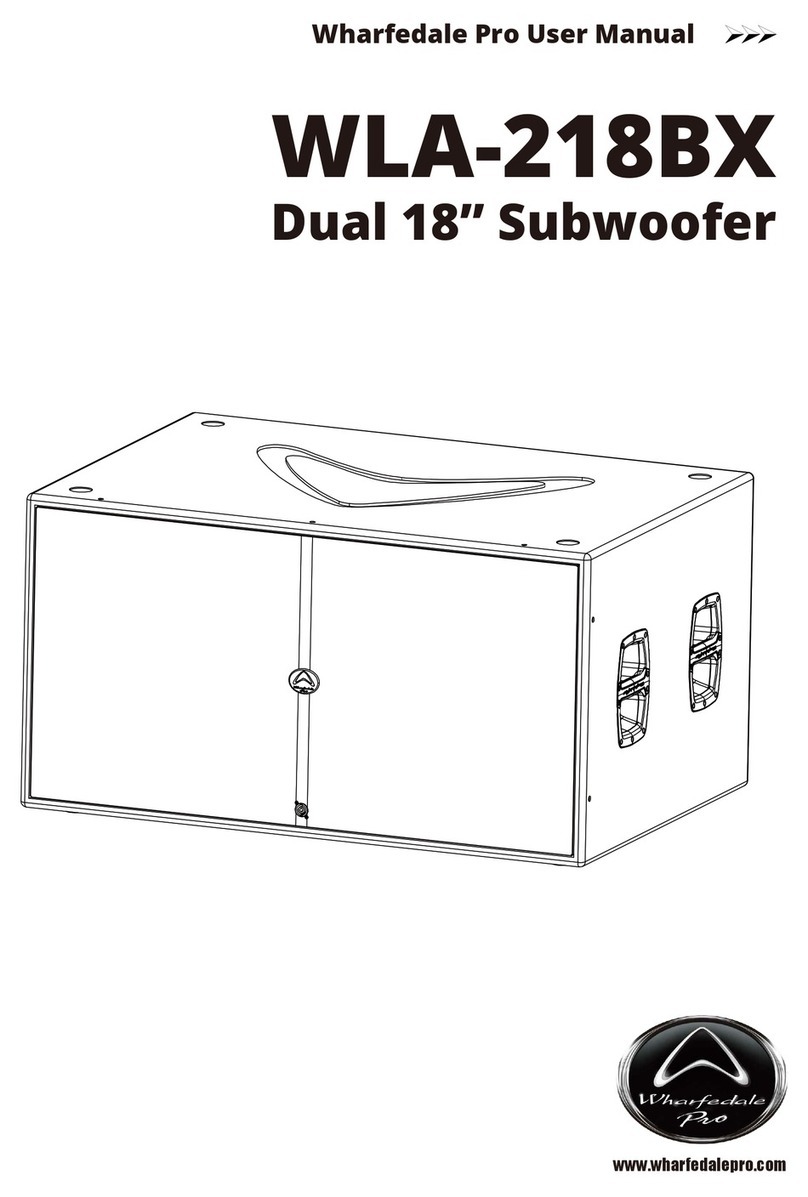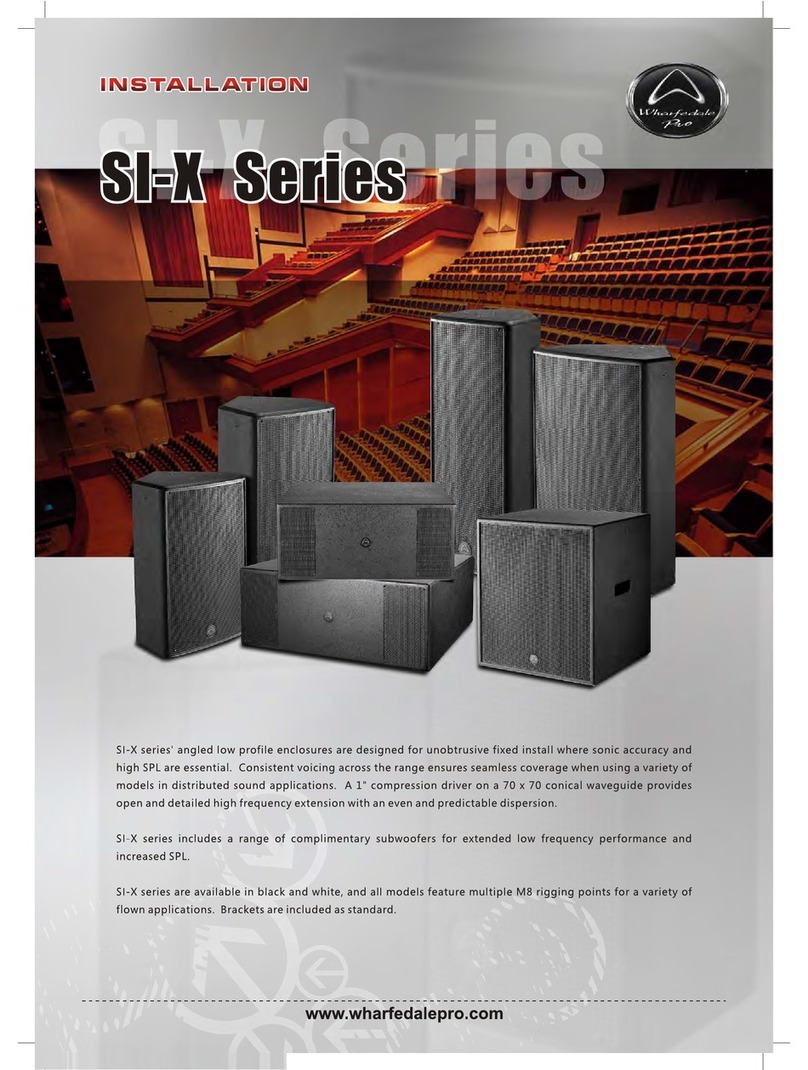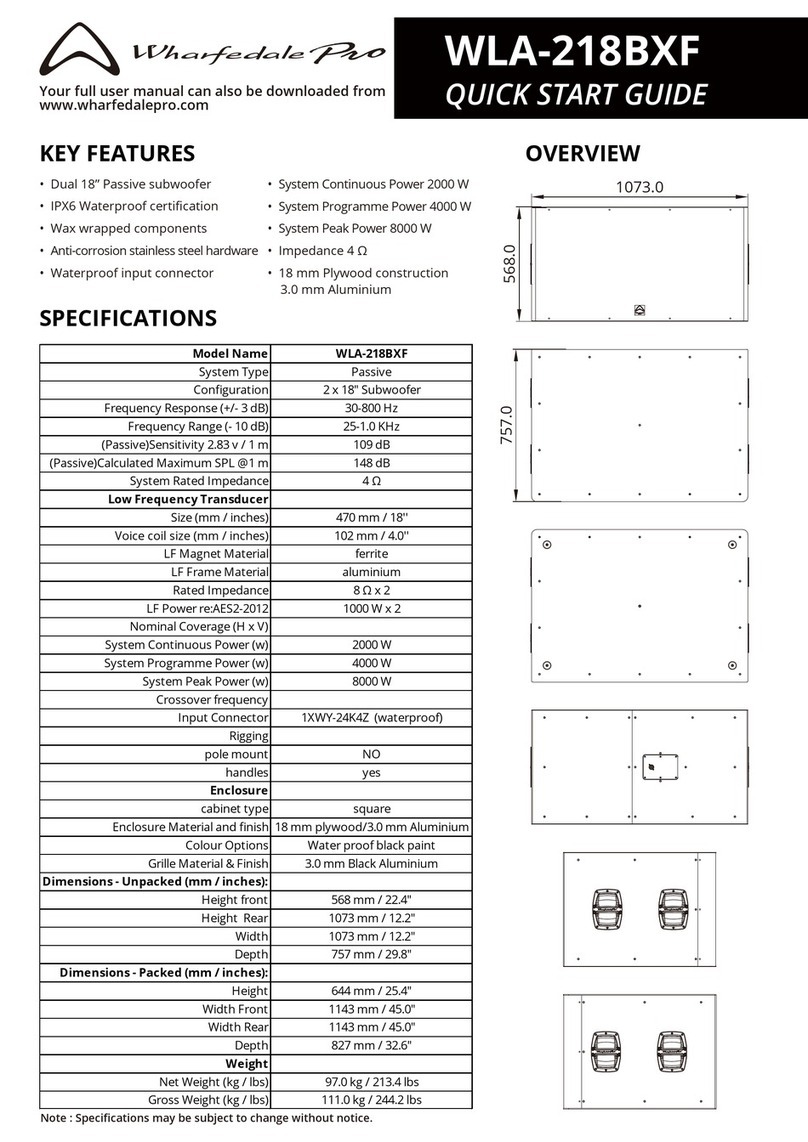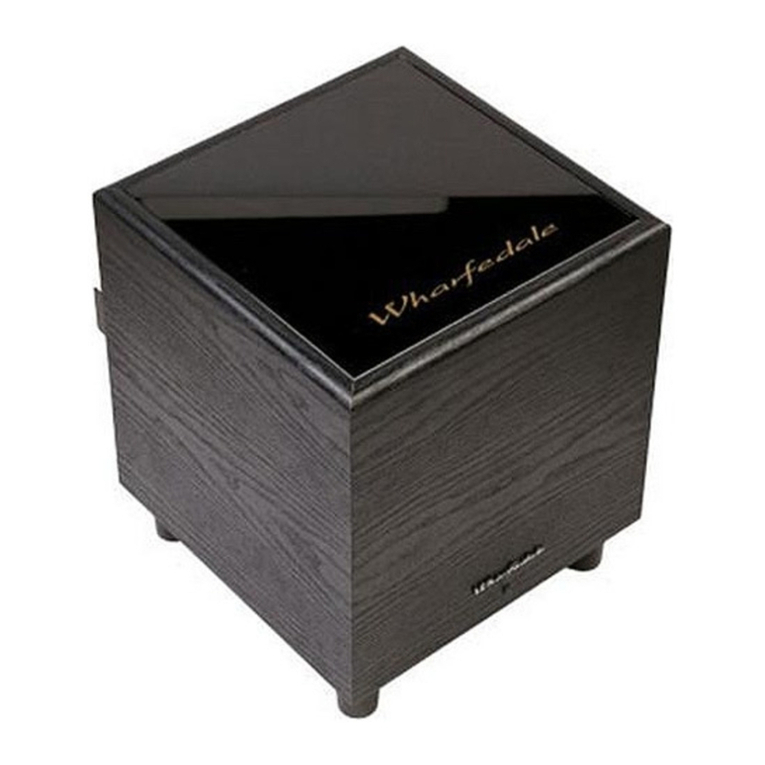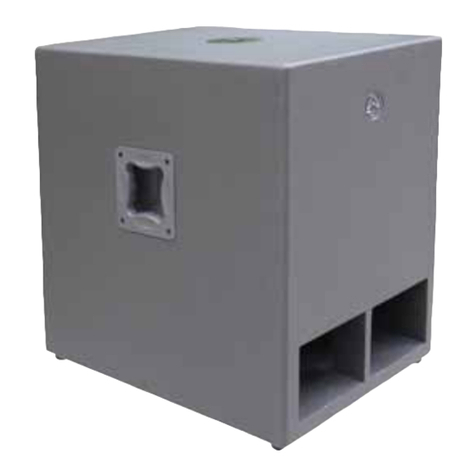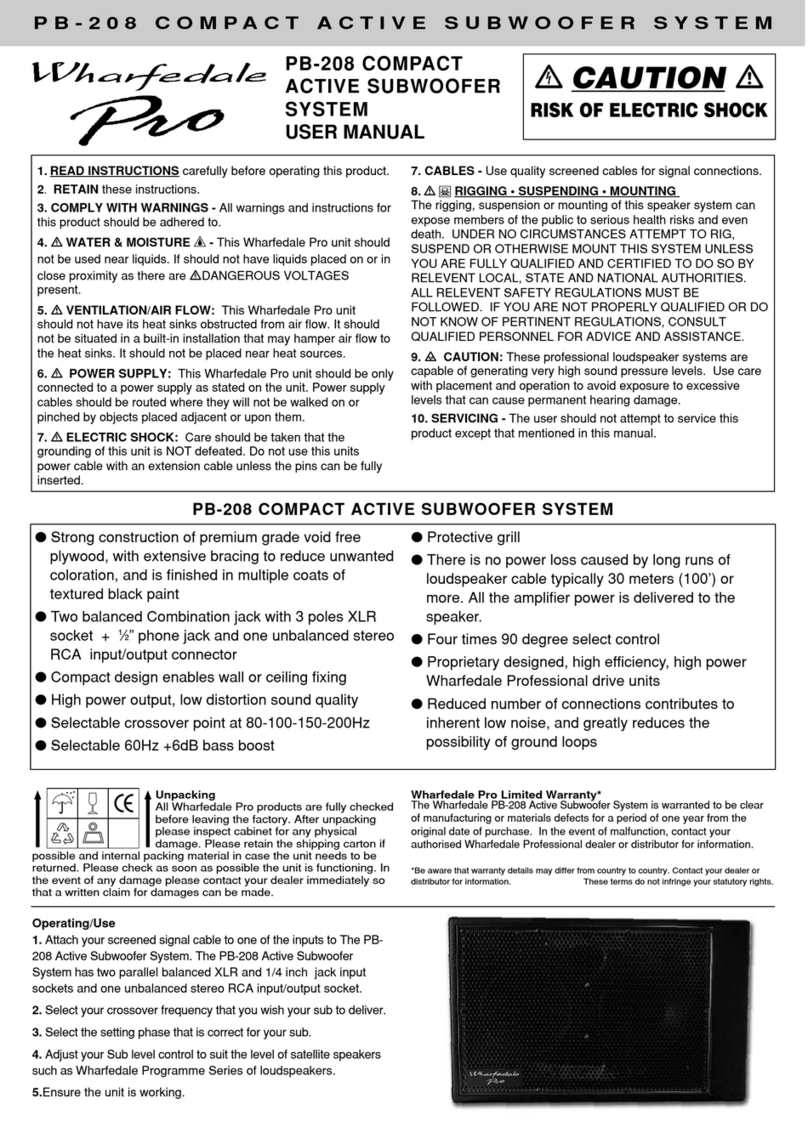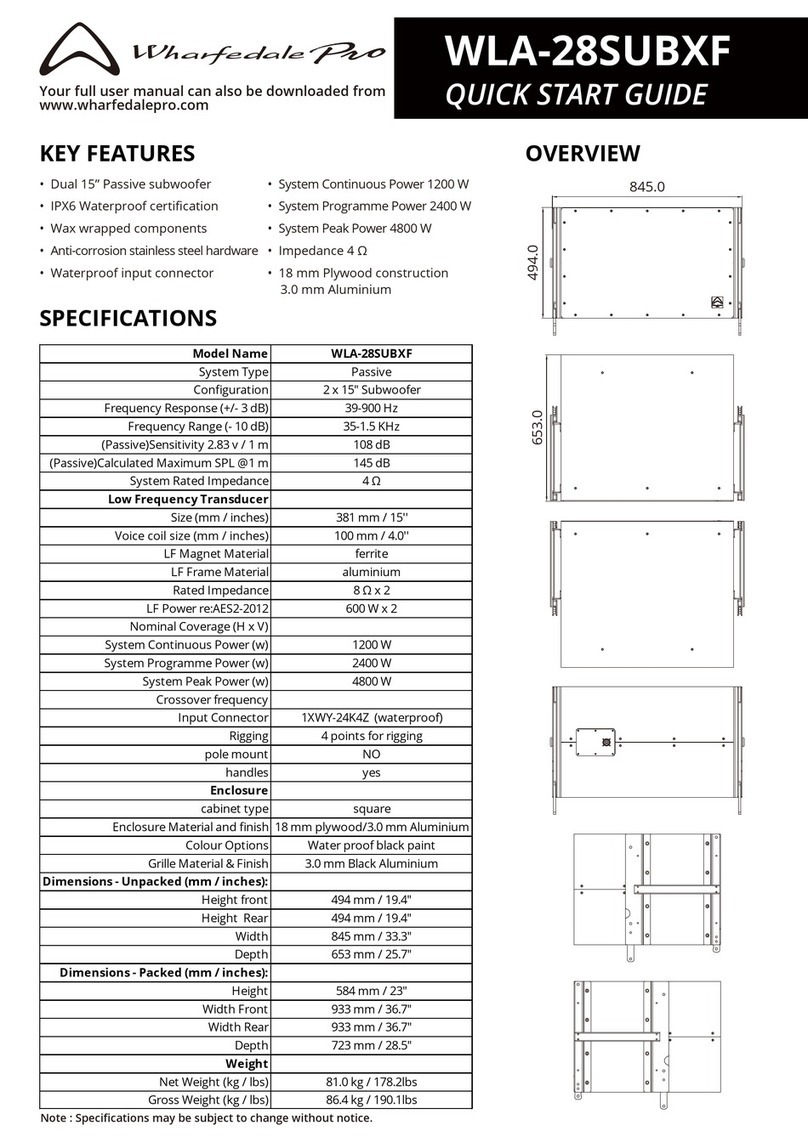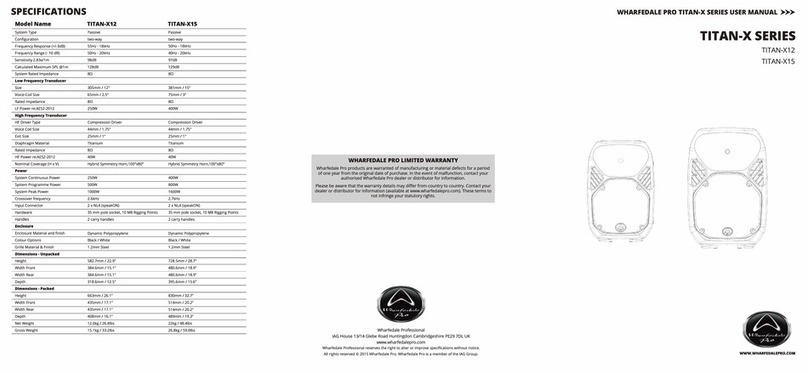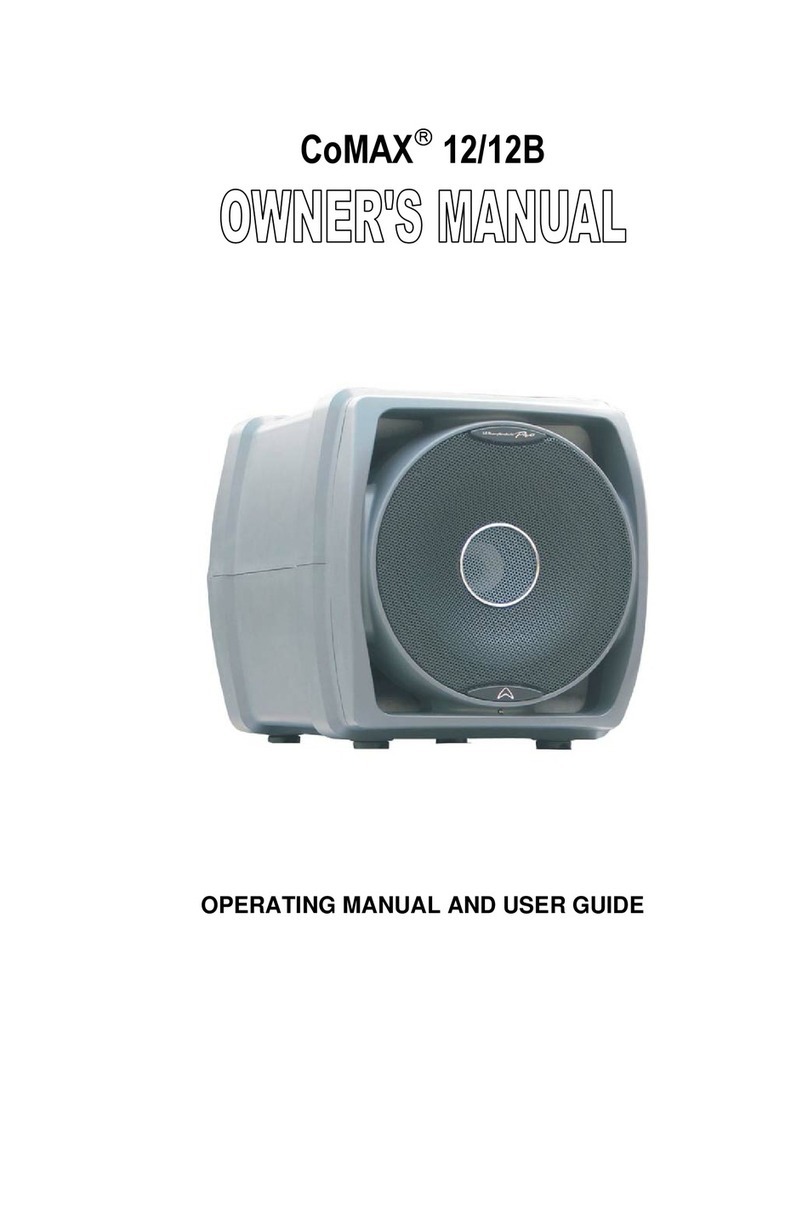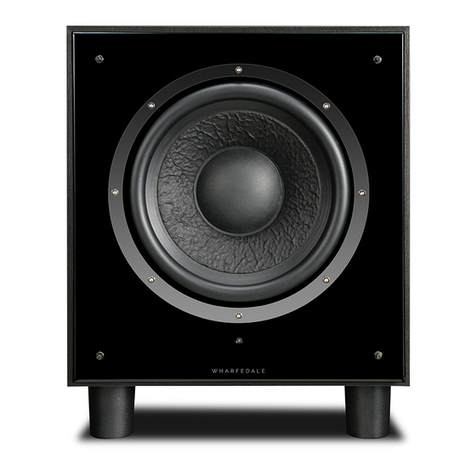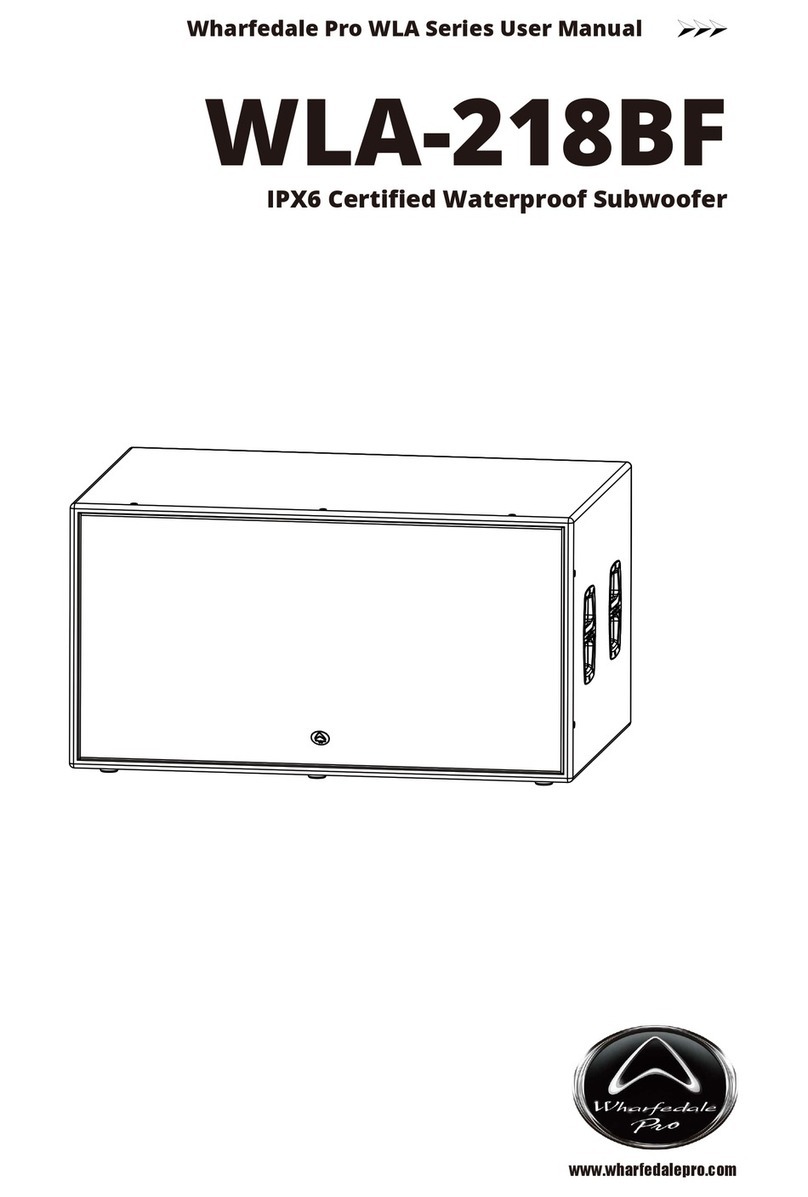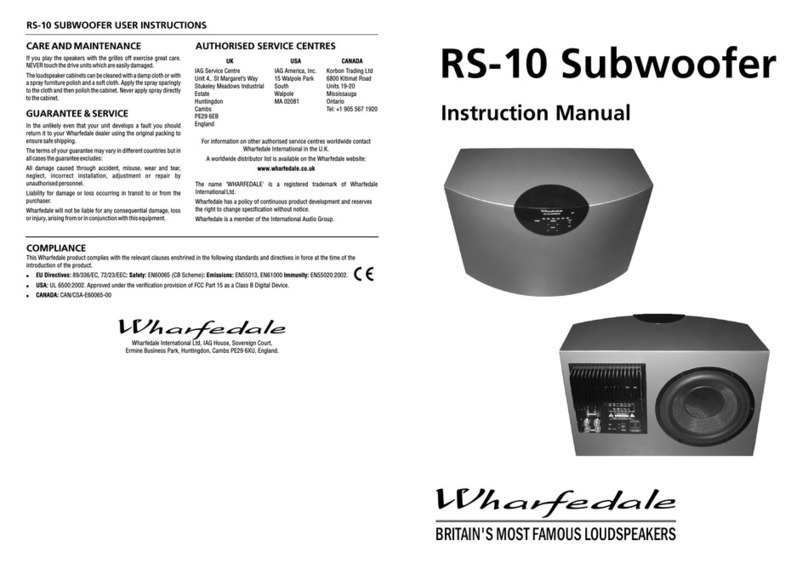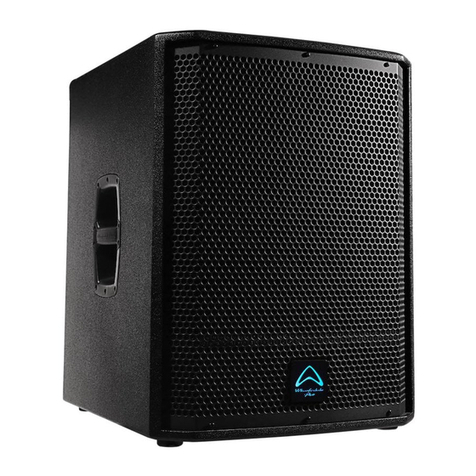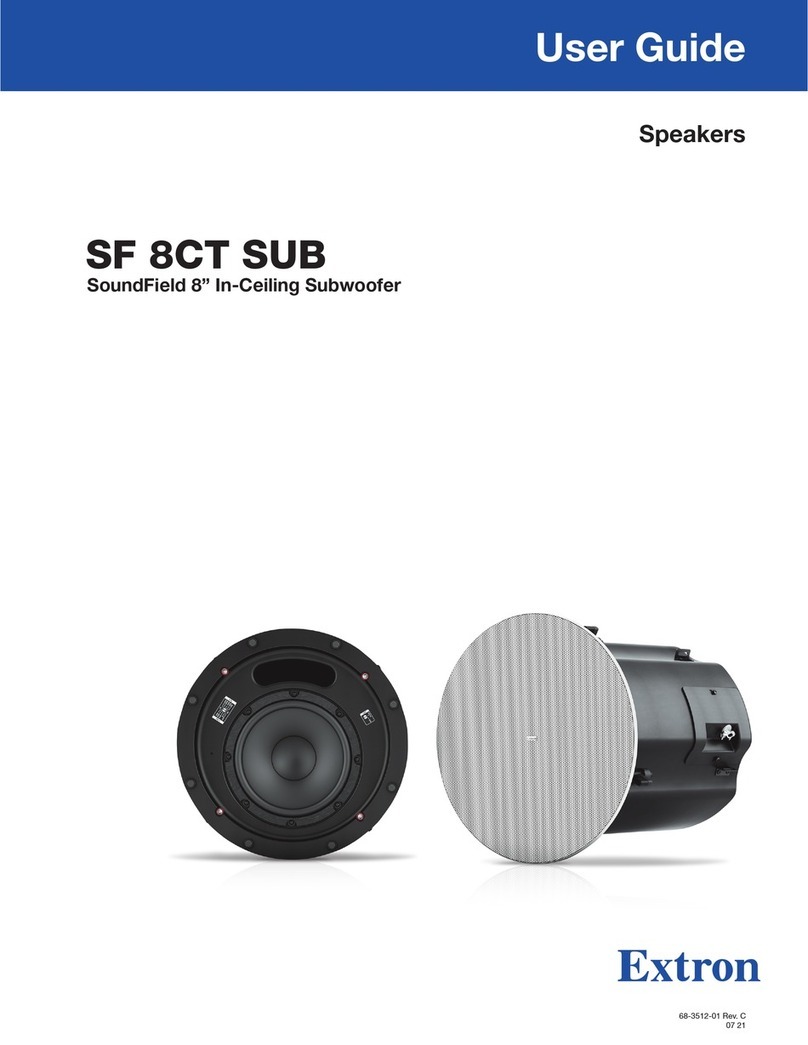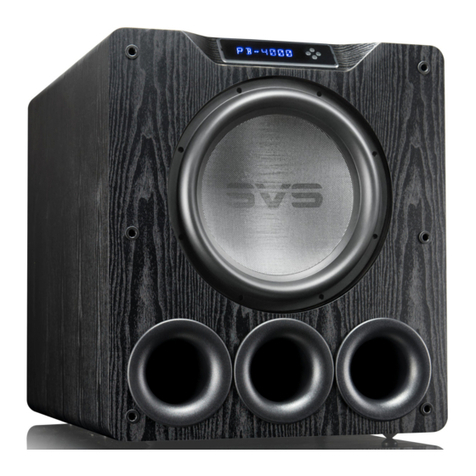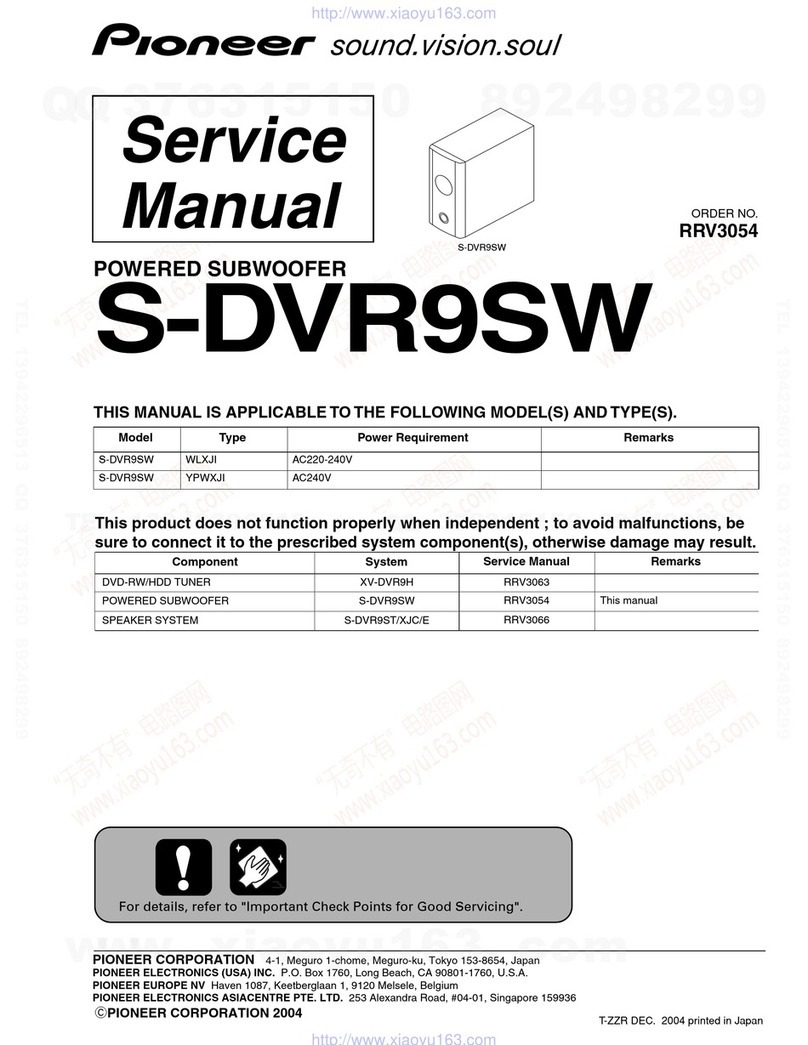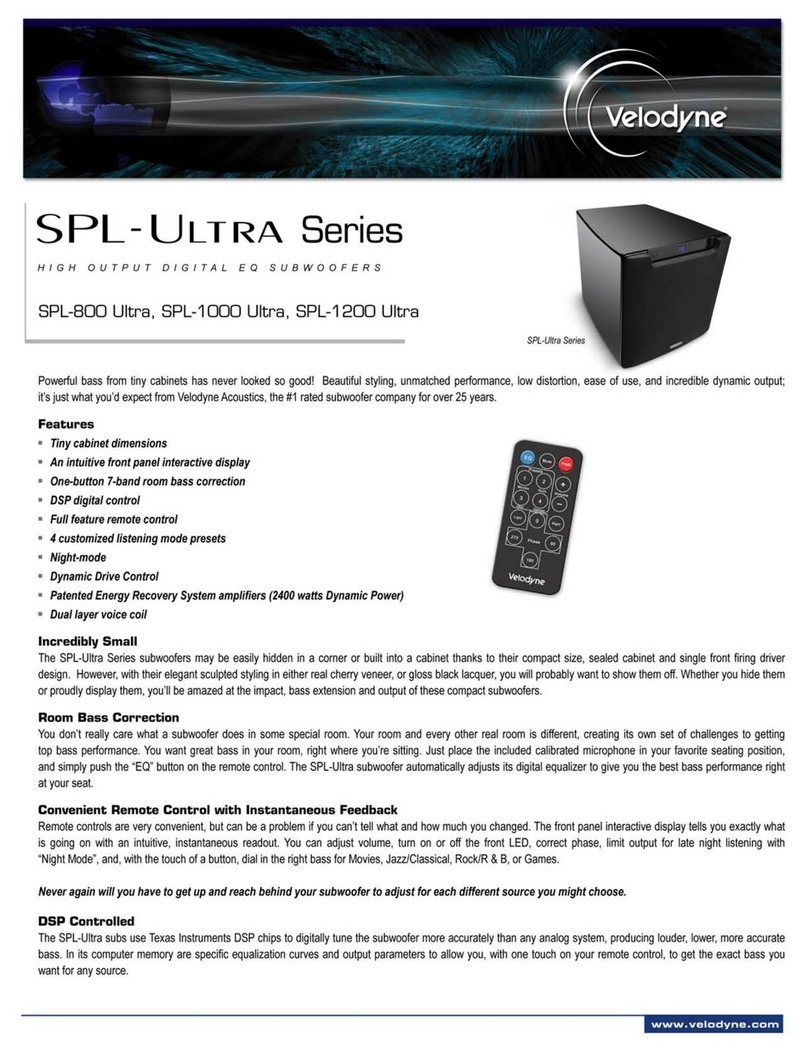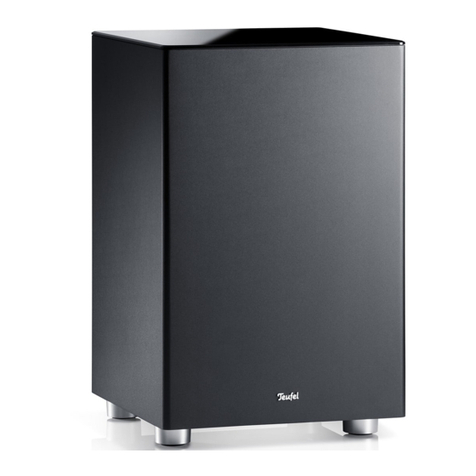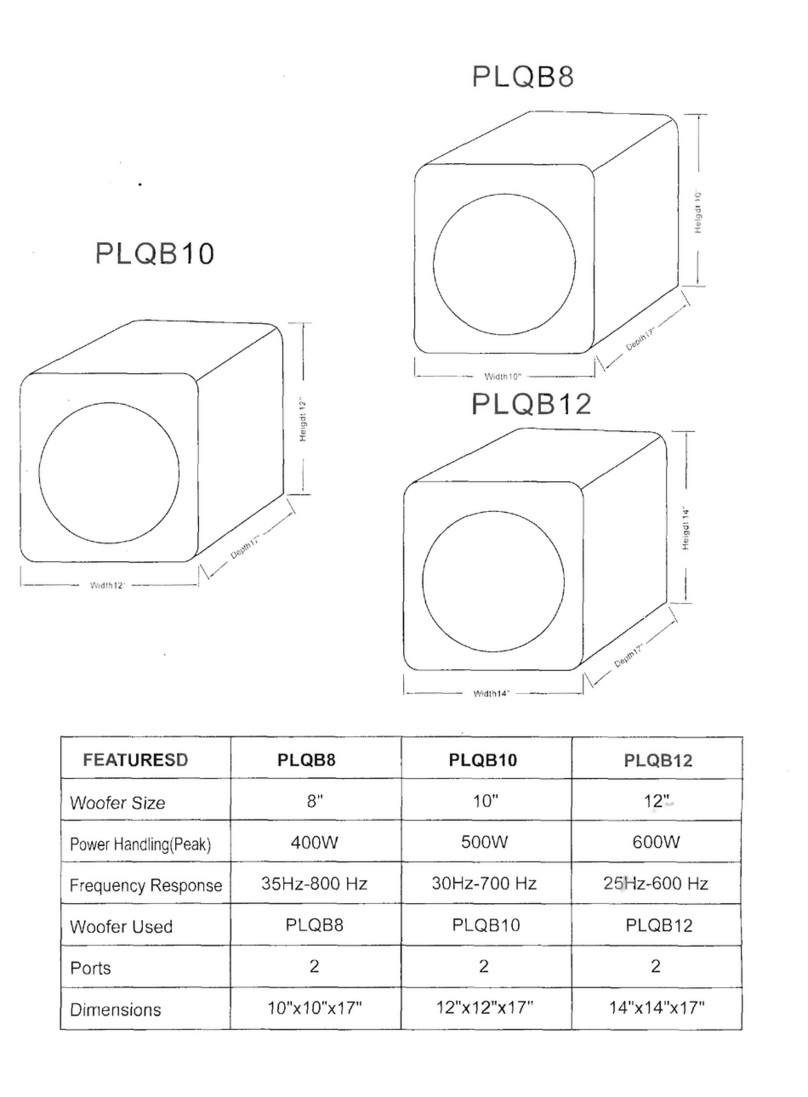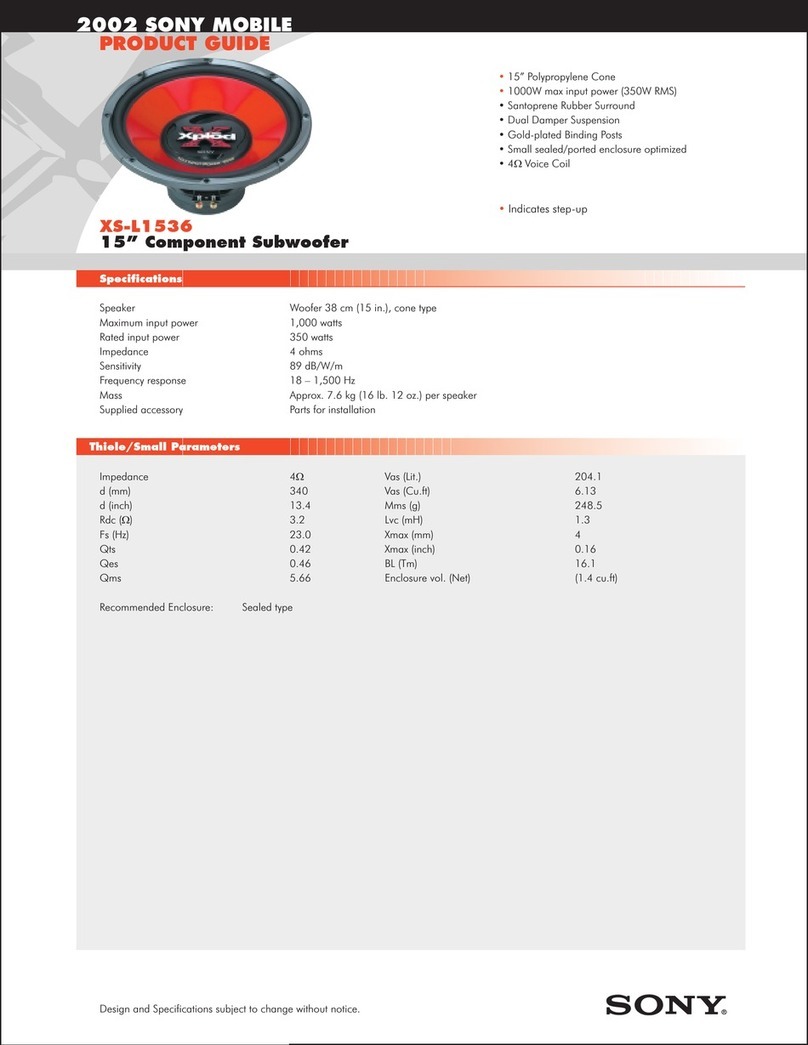The subwoofer has to blend with the main speakers: if you place the lower the subwoofer volume level.
subwoofer where it amplifies the irregularities of the room or the main Note: If any channels are set to ‘Small’ the subwoofer must be on when
speakers the result will be bloated, coloured bass. If acoustic guitar and the system is playing otherwise there will be reduced bass , as well as no
male voice sounds coloured when the subwoofer is operating and less LFE.
coloured when in standby, you need to address the positioning first Stereo reproduction
before adjusting any controls. Low Pass Filter: The low pass filter should be set having regard to the
Loudspeaker Phasing size and low frequency extension of the main speakers. The role of the
Make sure that all loudspeaker channels are connected in phase. Nothing subwoofer is to extend the bass response of the system not to increase
is more certain to defeat a Home Cinema or Stereo setup involving a the overall bass level. If the loudspeakers are large the LPF should be set
subwoofer than one(or more) channels being out of phase. In Stereo, if low, a value around 45-55 Hz is a good place to start. With smaller
there is a doubt about the way the loudspeakers are connected, check speakers this can be increased, up to 85Hz for very small bookshelf
their phasing by playing a mono source - the sound should appear from a units. As always the final value is determined by listening.
point midway between the two loudspeakers. If this position is indefinite, Low-level listening
reverse the connections to one of the loudspeakers. Correctly connected Our ears are far more sensitive to midrange frequencies (2-5 kHz) than
loudspeakers give a definite centre sound source with fuller bodied tenor bass frequencies. Very low bass and especially percussive bass is ‘felt’
and bass registers. rather than heard. At low sound levels bass frequencies appear to
Setting the Phase of the Subwoofer attenuate faster than midrange and treble. As the level increases this
Phase at very low frequencies is not straightforward to detect. Initially bass roll-off decreases and at loud volumes is negligible. The pioneering
we suggest you temporarily set the low pass filter to ‘OFF’ and the phase work was done in the 1930’s by Fletcher and Munson who produced a
to 0º and play some bass heavy music in Stereo through the main series of ‘Equal Loudness Contours’. Occasionally we may wish to listen
speakers and the subwoofer. From the listening position, switch the to a normally loud piece of music at a low level but with retention of the
phase between 0º and 180º. The setting which appears to give the greater bass information. There may be a case for assigning a preset for low
bass output is correct. Now follow the instructions below for setting the level listening where the subwoofer volume is set somewhat higher and
low pass filter. the LPF is set a little lower - as always this is for individual judgement.
Home Cinema Systems Testing the system By Ear
Low Pass Filter The simplest way to test the system is to play, at a moderate level, music
with deep consistent bass. Switching the subwoofer in and out of
If you are using a digital AV processor the initial setting should be ‘OFF’ Standby should cause change of the depth of bass, and the ambience will
as the processor will have its own bass management system. Most also alter. If there is a significant change in bass volume, or a noticeable
digital AV Processors ask you to specify the size of speakers in the step in the bass response, or an increase in coloration when the
various channels. These are usually ‘Large’ or ‘Small’. This sets the bass subwoofer is playing, the setup needs to be refined further. By entering
management for the system. Unless your loudspeakers are large floor different settings in different presets, you will be able readily to identify
standing units, you should choose 'Small' for the Front channels, as the the most favourable combination.
subwoofer is going to be better at providing clean, deep bass. Choose
'Small' for the surround channels and also for the Centre channel, so that Using an SPL Meter
any bass from these channels will be directed to the subwoofer. Set the This is done with a test disc or signal generator and is beyond the scope
‘Subwoofer’ option on the processor to 'On’ or 'Yes'. of this handbook except to observe that SPL meter settings are weighted
After experimenting with various sources you may need to adjust the LPF ‘A’, ‘B’ and ‘C’ - these correspond to the inverse of the Fletcher-Munson
settings. The goal is to ensure the subwoofer blends seamlessly into the Equal Loudness Contours at 40, 70 and 100dB. For normal listening
sound stage. Setting the subwoofer to Standby should reduce the bass levels the SPL meter is usually set to ‘C’ and the response set to slow. If
extension, not change the bass level - as always personal taste plays an you wish to use this setup method you should definitely seek your
important part. dealer’s advice beforehand.
Setting levels
Once the loudspeaker settings have been finalised, put the AV amplifier
into its “Test” mode (see instructions supplied with your processor.)
Adjust the levels until all channels are reproduced at equal loudness.
When adjusting the subwoofer output level avoid setting too high a level
or you will swamp the sound with bass which is tiring to listen to and
may limit the subwoofer’s ability to respond to large bass transients. Set
a sensible level going into the subwoofer from the processor. The
volume display should be around 50 at normal listening levels.
LFE
This channel was originally an additional bass channel with its own
dedicated subwoofer. In practice however, if any speakers are set to
‘Small’, the LFE channel is combined with the bass from those channels
and fed into the subwoofer. When you set the LFE level from your AV
processor, use care as the LFE channel contains powerful low
frequencies which, although normal in a cinema, may overload a
domestic subwoofer. If, during a programme, you hear popping or
thumping noises from the subwoofer, turn the AV Processor volume
level down and back off the LFE level. If this does not cure the problem,
In 1932, when Gilbert Briggs founded the Wharfedale Wireless
Works, his company was at the leading edge of an exciting new
technology which was dedicated to bringing the pleasure of music
and entertainment to a wide range of people. As the technology
advanced Wharfedale gave many music lovers their first taste of
High Fidelity, mounting a series of live sound demonstrations
which excited the audio world and heralded the era of the modern
hi-fi loudspeaker.
Today Wharfedale still takes the same uncompromising
approach to the design and manufacture of every loudspeaker
system, using high quality components and state-of-the-art
testing to ensure consistently high performance. And that
means that you can continue to count on the quality of all
Wharfedale products.
Loudspeaker Manufacturers since 1932
Page 6 Page 3
PRELIMINARIES REAR PANEL CONNECTIONS
Open the carton and remove all the top packing pieces. Lift the
subwoofer out taking care not to damage the cabinet. When lifting the
unit from the carton support it from the bottom. DO NOT attempt to lift
the subwoofer out of the carton using the polythene bag. The unit is
heavy; if you cannot manage it easily, get someone to assist you.
Retain the packing materials for future use or return them to your dealer.
If you decide not to keep the packing, please dispose of it having regard
to any recycling regulations in your area.
Please retain the user manual and the purchase receipt for future
reference. If you transfer this equipment to a third party, please ensure all
the instructions are passed on with the product.
Fitting the feet
Carefully invert the subwoofer. Protect the top by placing it on a soft
surface such as a towel. Open the polythene bag and slide it part-way
down the cabinet.
The subwoofer is provided with two short spikes and two long spikes.
The longer spikes have an adjustable top cap for levelling. Fit the spikes
as shown. When all four screw feet have been fitted, stand the subwoofer
upright and remove the bag.
Connecting the Subwoofer
Connecting to a Digital AV processor
Tighten the front feet with a suitable wrench. With the aid of a spirit level,
screw each rear foot in and out until the subwoofer is level (side to side
and front to back) and firmly supported on all four feet. Tighten each rear
foot to its top cap with a suitable wrench to lock the assembly in position. Stereo Line Level Connections
Note: When using spiked feet take care not to drag the subwoofer and be Stereo line level connections will be necessary where there is no
careful not to pierce objects or cables which may be under carpets, etc. dedicated single subwoofer output, but where there is either :
INSTALLATION !A stereo subwoofer line output or a separate preamp output.
!In stereo systems where there is a suitable preamplifier line output,
or if an integrated amplifier, a pre/main link that can be separated.
The output must be controlled by the system volume control - a tape
output is not suitable. If you are in doubt, consult your dealer.
Stereo Connections: Connect a stereo RCA phono cable from the line
output of the preamp to the Subwoofer line inputs.
Power Connections
Before connecting your subwoofer check that the mains voltage marked
on the amplifier panel is correct for your mains supply.
!230 volt products - 220 volts to 240 volts
!115 volt products - 110 volts to 120 volts
If your AV processor has a line level or LFE subwoofer output you should
use this connection. You will need to purchase a single screened RCA
phono lead from your dealer. Connect this lead to the Left line input of the
Subwoofer as shown below.
Positioning the subwoofer
Although the unit may be placed almost anywhere in the room, we
recommend that is placed in front of the listener central to the listening
position. There should be a mains outlet within easy reach. There should
be a line of sight between the listener and the front of the subwoofer
otherwise the remote functions will not work. We suggest you initially
position the subwoofer about 20cm (8 inches) from the wall. Placing it
close to the wall will increase the bass; placing it across a room corner
will increase the bass further, possibly at the expense of clarity. Do not
place the subwoofer close to surfaces or objects that may rattle. The
floor under the subwoofer should be sound. with a variety of
locations and sources before making a final decision.
Experiment
See Pgs. 4 and 5.
Mains Input Speaker (High) Level Inputs
Mains Fuse Line Level Outputs
Mains Power Switch Line Level Inputs
A/V PROCESSOR
SUBWOOFER
OUTPUT i fkb=i b sbi
LEFT
INPUT
OUTPUT
RIGHT
SUBWOOFER
A/V PROCESSOR/STEREO PREAMP
Preamp Output i fkb=i b sbi
LEFT
INPUT
OUTPUT
RIGHT
SUBWOOFER
AC 220-240V~50Hz 400WAC 220-240V~50Hz 400W
FUSE T4AL250V FUSE T4AL250V
POWERPOWER
ibcqibcq
SPEAKER LEVEL INPUTSSPEAKER LEVEL INPUTS
INPUT
OUTPUT
LINE LEVELLINE LEVEL
ofdeqofdeq
OFFOFF
ONON
AVIS: RISQUE DE CHOC ELECTRIQUE AVIS: RISQUE DE CHOC ELECTRIQUE
-NE PAS OUVRIR-NE PAS OUVRIR
>>
WARNING: SHOCK HAZARD WARNING: SHOCK HAZARD
-DO NOT OPEN-DO NOT OPEN
` ^r q fl k` ^r qfl k
ofph=lc=bib`qof`=pel`hofph=lc=bib`qof`=pel`h
al=klqal=klq =lmbk=lmbk
SW 300 SUBWOOFERSW 300 SUBWOOFER
WHARFEDALE INTERNAWHARFEDALE INTERNATIONAL LTD,HUNTINGDON, UNITED KINGDOMTIONAL LTD,HUNTINGDON, UNITED KINGDOM
LEFT RIGHT
SERIAL No:SERIAL No:
Wharfedale SW 300 Subwoofer User Guide Wharfedale SW 300 Subwoofer User Guide
pÅêÉï
cççí
qÜêÉ~ÇÉÇ
t ~ëÜÉê
